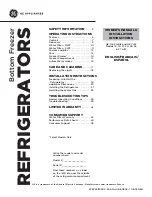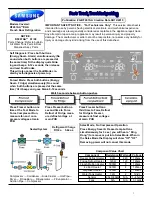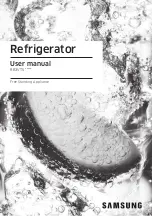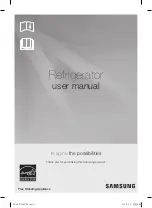
5
Complete the Installation
1. Plug into a grounded 3 prong outlet.
NOTE: Allow 24 hours to produce the first batch of ice. Discard
the first three batches of ice produced. Allow 3 days to completely
fill the ice container.
Refrigerator Door(s) and Drawer
Graphics are included later in this section.
Remove and Replace Handles
1. Using a
³⁄₃₂
" or
¹⁄₈
" hex key, loosen the two setscrews located
on the side of each handle. See Graphics 1 and 2.
2. Pull the handle straight out from the door. Make sure you keep
the screws for reattaching the handles.
3. To replace the handles, reverse the directions.
Remove Doors and Hinges
IMPORTANT:
■
Remove food and any adjustable door or utility bins from
doors.
■
All graphics referenced in the following instructions are
included later in this section after “Final Steps.”
TOOLS NEEDED:
⁵⁄₁₆
",
³⁄₈
",
¹⁄₄
" hex-head socket wrench,
#2 Phillips screwdriver, and a flat-blade screwdriver.
1. Unplug refrigerator or disconnect power.
2. Keep the refrigerator doors closed until you are ready to lift
them free from the cabinet.
NOTE: Provide additional support for the refrigerator door
while the hinges are being removed. Do not depend on the
door gasket magnets to hold the door in place while you are
working.
3. Starting with the right-hand side door, remove the parts for the
top hinge as shown in Top Hinge graphic. Lift the refrigerator
door from the bottom hinge pin.
NOTE: Remove the hinge pin cover from the bottom hinge pin
and keep it for later use. See Bottom Hinge graphic.
4. Before removing the left-hand side door, disconnect the wiring
plug located on top of the top hinge by wedging a flat-blade
screwdriver or your fingernail between the two sections. See
Wiring Plug graphic.
5. Remove the parts for the top hinge as shown in Top Hinge
graphic. Lift the left-hand side door from the bottom hinge pin.
NOTE: Remove the hinge pin cover from the bottom hinge pin
and keep it for later use. See Bottom Hinge graphic.
Replace Doors and Hinges
1. Assemble the parts for the top hinge as shown in Top Hinge
graphic. Do not tighten the screws completely.
2. Replace the parts for the bottom hinge as shown in Bottom
Hinge graphic. Tighten screws. Replace the refrigerator door.
NOTE: Provide additional support for the refrigerator door
while the hinges are being moved. Do not depend on the door
gasket magnets to hold the door in place while you are
working.
3. Align the door so that the bottom of the refrigerator door
aligns evenly with the top of the freezer drawer. Tighten all
screws.
4. Reconnect the wiring plug on top of the left-hand side
refrigerator door.
5. Replace the top hinge covers.
Remove and Replace Freezer Drawer Front
IMPORTANT: Two people may be required to remove and replace
the freezer drawer front. Graphics are included later in this
section.
Remove Drawer Front
1. Open the freezer drawer to full extension.
2. Loosen the four screws attaching the drawer glides to the
drawer front. See Drawer Front Removal graphic.
NOTE: Loosen screws three to four turns. Keep the screws in
the drawer front.
3. Lift drawer front upward and off the screws. See Drawer Front
Removal graphic.
Replace Drawer Front
1. Slide the drawer glides out of the freezer compartment. Insert
the screws in the top of the drawer front into the slots in the
drawer brackets. See Drawer Front Replacement graphic.
2. Pull the drawer brackets toward you to position the two
screws in the bottom of the drawer front into the brackets.
See Drawer Front Replacement graphic.
3. Completely tighten the four screws.
Final Steps
1. Plug into a grounded 3 prong outlet.
2. Return all removable door parts to doors and food to
refrigerator.
Electrical Shock Hazard
Plug into a grounded 3 prong outlet.
Do not remove ground prong.
Do not use an adapter.
Do not use an extension cord.
Failure to follow these instructions can result in death,
fire, or electrical shock.
WARNING
Electrical Shock Hazard
Plug into a grounded 3 prong outlet.
Do not remove ground prong.
Do not use an adapter.
Do not use an extension cord.
Failure to follow these instructions can result in death,
fire, or electrical shock.
WARNING






































